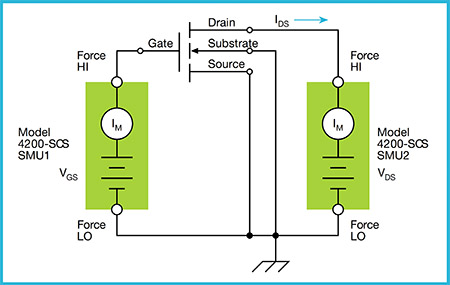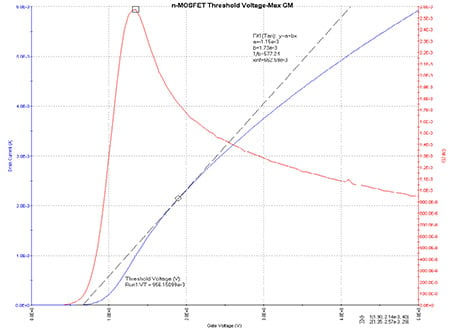Question :
How do you find the transconductance of a MOSFET?
Answer :
Transconductance is a key test for validating the MOSFET performance in power electronics designs. It ensures that a MOSFET is functioning properly and helps engineers choose the best one when voltage gain is a key spec for their circuit designs. This, in turn allows companies to take power semiconductor devices to market faster while minimizing failures in the field.
Transconductance is the ratio of drain current (ID) to gate-source voltage (VGS) when a constant drain-source voltage is applied. The current to voltage ratio is commonly referred to as gain. Transconductance is a critical parameter strictly connected with the threshold voltage (VTH) of MOSETs and both are related to the size of the gate channel. The formula for deriving the transconductance of a MOSFET from I-V measurements is:
|
gm= |
ΔID |
|
ΔVGS |
How to measure transconductance of a MOSFET?
The approach shown in the first configuration calls for three source measure units (SMUs), allowing every node to be held at a feedback-controlled voltage and every current to be measured simultaneously. If you don’t have enough SMU channels to cover each device channel connection, it is possible to proceed as shown in the second configuration. It should be noted that this configuration is more susceptible to a noisy ground connection and can produce ground loops if long cables are used. Also, the current and voltage at the source terminal cannot be measured, which can lead to errors in calculations.

Measuring transconductance
- Sweep the gate voltage (VGS) over the desired range, while maintaining a constant drain/source voltage (VDS)
- Measure the drain current (ID) at each increment step of VGS.
- Calculate transconductance (gm) by dividing the small changes in the current ID by the small changes in VGS.

The red plot line shown here illustrates the transconductance (gm) and the maximum transconductance value (Vth).
Learn more about safe, precise and fast MOSFET device characterization tests.
This FAQ Applies to:
No product series
Product:
FAQ ID 783013
View all FAQs »
